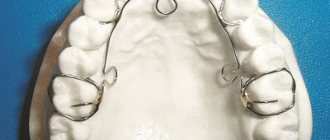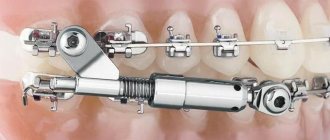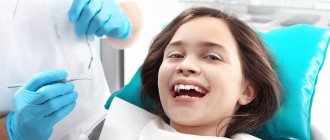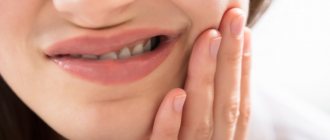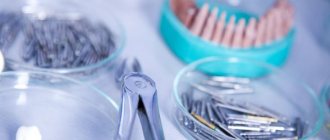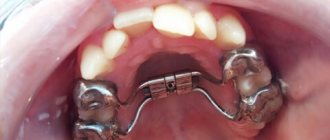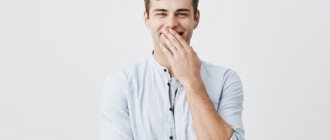Plates for teeth: removable and non-removable
In dentistry, doctors work with different types of orthodontic products. At the initial appointment, the orthodontist will tell the young patient and his parents what the plates for straightening teeth are called, how they differ and what they are like. The most popular:
- systems – single-jawed, with a retraction arch, with a pusher, with a hand-shaped process;
- devices – Brückle, Frenkel;
- Andresen-Goipl activator.
Products are divided according to the method of fixation:
- removable – hypoallergenic polymer construction includes wire hooks and arcs for fixing the plate;
- non-removable – they look like metal brackets that put pressure on the teeth from the outside, forming the correct bite.
A removable dental plate is placed on children to correct simple bite defects. The optimal age of a child for correction is 5-12 years. Fixed products can compete in effectiveness with braces; they are usually recommended for teenagers to eliminate serious anomalies of the dentition.
Braces are non-removable orthodontic structures in which a plate is placed on each tooth, and an arch with a “memory effect” is responsible for correcting the bite. Metal braces are the most effective, but sapphire and ceramic braces are almost invisible on the teeth. There are also ligature braces with rubber bands and self-ligating ones, which reduce the treatment period by several months.
Sizes and types. What are they made of?
Most plates are made either from food-safe plastic, which provides a rigid frame, or from soft silicone. The choice of material depends on the doctor's decision. Children's plates are made in two sizes:
- first (I) for children with primary malocclusion. Its radius is 22.5 mm. The product can be distinguished by the characteristic red color of the ring;
- the second (II) for children with mixed dentition. Its radius is 30 mm. She has a dark blue ring.
There are several varieties of vestibular plates . All of them appeared later than the standard one and, in addition to the development of nasal breathing, help to cope with the problems of a “flaccid” tongue, eliminate speech defects, correct swallowing, etc. The three most popular models are: classic, with a bead, with a flap and with a visor.
Model with visor
The visor appeared on vestibular orthodontic plates when doctors realized that it was difficult for children with underdeveloped jaws and protrusion of the upper frontal teeth to hold the classic model in their mouth. For them, it constantly deviated above the sagittal protrusion, and at night it completely fell out. The presence of a visor solves this problem.
The vestibular plate with a soft or hard visor is ideal for the treatment of all class II abnormalities. It also stops the development of class III anomalies if worn with the visor up. Due to the fact that the product pushes the upper jaw forward, wearing it normalizes the position of the jaws relative to each other.
Model with damper
The tongue deflector plate is designed for those children who are accustomed to placing their tongue between their teeth when swallowing and speaking. This habit interferes with the normal growth of teeth and leads to the formation of an “open” bite. The flap pushes the tongue back and forces it into the correct position.
In addition, a vestibular plate with a tongue flap helps:
- eliminate the habit of breathing through your mouth;
- teach the child to correctly position the tongue in the mouth during speech;
- strengthen the circular muscle of the tongue, normalize lip closure.
Because the model is often used with speech therapists to demonstrate proper tongue placement, it is made transparent.
Model with bead
The vestibular bead plate is used primarily to correct speech problems. It helps stimulate “flaccid tongue” in children with speech impediments. The standard plate itself aligns the position of the tongue, teeth, lips, helping to improve diction, and an additional design element enhances the effect.
There are two models of bead plate :
- classical. It has an extended bead that stimulates the root of the tongue. This model helps with dysarthria, increased muscle tone, impaired pronunciation of hard and soft consonants, rhinolalia, tachylalia, as well as in the treatment of stuttering. It helps to train weakened tongue muscles;
- new model. Her bead is moved closer to the plastic base and teeth. This model of plate is recommended for children with reduced tone of the tip of the tongue, various forms of sigmatism, lambdacism, and problems with the pronunciation of the “r” sound.
If for some reason a parent wants to buy a record without a doctor’s recommendation, it is advisable to purchase a standard model. It is universal, easy to use, and there is no negative effect when using it. All specialized models - with a bead, a visor, a flap - must be purchased exclusively on the recommendation of a doctor.
Does a plate straighten teeth: indications
Children are prescribed plates for the lower teeth and expansion plates for the upper and lower teeth only after a thorough diagnosis. Based on X-ray and panoramic photographs, measurements and study of proportions, the orthodontist decides to place a plate on the child’s teeth.
Treatment is indicated for:
- minor and serious anomalies of dental bite;
- violation of the tone of individual muscles;
- pathologies of tooth growth in the upper or lower jaws;
- incorrect position of incisors and canines;
- disproportionate growth and development of the dentofacial rows.
Orthodontic removable appliances equalize the growth rate of the jaw bones, straighten teeth in given planes, and correct the closure of the jaws.
Installation
Before an impression of the teeth is made for the plates and they are placed (put on), the patient undergoes a complete dental and orthodontic examination, including x-rays of the entire jaw. Afterwards, plaster models are individually made, on the basis of which the arches are made. The structure of the oral cavity of each patient is unique, and it is impossible to use braces created for one person in the treatment of another. The base of the structure should tightly grip the gums and dental contour, and the structure itself should securely fix the device in the desired position, applying pressure to the places that require correction.
What do children's dental plates look like?
A plate made in a pediatric dental laboratory is a standard of aesthetic perfection. Any shades, gradient colors, sparkles and bright decorations inside translucent plastic - children are delighted when they see it for the first time.
Structurally, the plate is:
- the base is strong and quite rigid;
- elastic wire - fasteners, arches and hooks are made from it, and it is this wire that provides the necessary pressure to correct the bite;
- the screw is an activator responsible for pressure and intensity of impact.
The screw is tightened by the doctor with a special key, or this is done by the parents according to the correction plan drawn up.
Soldatenkova Alina
I am often asked how dental plaques are made for children. First, we take impressions of the teeth – it doesn’t hurt, but sometimes it’s a little unpleasant. Then, based on the impressions, the appliance prescribed by the orthodontist is manufactured in a dental laboratory. Then try it on and create a design that is comfortable to wear. And issuing a plate to the patient with recommendations for wearing
Plates or braces – what to choose for your child?
There shouldn't be such a choice at all. These types of orthodontic appliances have different functions and capabilities. If the plates affect all teeth in a row, then braces successfully solve isolated problems, remove severe curvatures of individual units, crowding, and severe malocclusions. Also, the plate cannot be used if traumatic periodontitis is diagnosed. It should be noted that today orthodontists successfully combine these methods of treating dental anomalies. So, first they can prescribe the child to wear a braces system, and when the defect becomes less noticeable - plates.
How to wear dental plates - recommendations for children and parents
Whether dental plates help is the main concern of parents. Much depends on how correctly the young patient wears the orthodontic apparatus.
The main requirements for wearing orthodontic plates:
- duration – up to 20-22 hours daily;
- care - morning and evening cleansing with pastes, gels, weekly deep cleansing in a special solution;
- remove the product when eating;
- Do not play with the orthodontic appliance - remove it and return it to its place in the mouth with your tongue.
The doctor will show you how to put the plate on your teeth at your appointment, but there is nothing complicated about it. Metal arches fix the structure, and the regulatory elements are responsible for gentle correction of the bite while wearing.
It happens that a child takes the product out of his mouth, and then cannot figure out how to put the plate on his teeth - it either falls off or does not fit into place. Such a circumstance may be preceded by the following events:
- the device was in the mouth for less than 12-14 hours a day, and the fixation was broken;
- supporting units have been removed or fallen out – the structure requires orthodontic correction;
- a tooth erupts under the polymer part of the system and prevents it from taking the correct position;
- the plate was not worn for several days in a row - the bite has returned to its original position and you need to see a doctor to adjust the device;
- violation of medical recommendations for wearing removable plates - it is worth coming to an appointment and checking the condition of the product.
Retention devices after removing braces
Even high-quality orthodontic intervention is not a guarantee that after the correction is completed, the situation will not return to its original course and the curvature will not return. To minimize the risk of this, after wearing the system (usually one and a half to two years), supporting and consolidating therapy is used, since the elements of the jaw retain increased mobility and tend to return to their old position. Typically the process lasts several years, 1.5-2 times longer than treatment - this is exactly what a dental plate is for.
The use of an arch does not involve such discomfort as the use of a brace system, and after it, the result will be almost unnoticeable. Also, it will not cause inconvenience to a person who is accustomed to careful oral care.
Not only wire elements can be used as a retainer, but also mouth guards that are placed on the teeth. The number of hours in a day during which a retention device must be worn is determined by the doctor based on the mobility of the patient’s jaw.
Until what age can teeth be straightened with a plate?
Until what age do plates be placed on teeth is a question to be decided on an individual basis. Some devices work best during the period of active changes in occlusion, so they are recommended to be worn until 10-11 years of age. Other products perform well until the teeth completely change - up to 12-14 years. But the doctor assesses the situation more fully.
Often, orthodontists use a combined treatment method - changing devices, selecting new ones for the current situation. That is why it is not always necessary to delve into the names of plates for straightening teeth. The result is important, not what the dental plates are called.
It is difficult to answer how long a plate is worn on the teeth. Some patients require full-time braces and additional treatment with braces at age 14. For others, the situation improves in 1-2 years.
During an orthodontic consultation at Aza&Buka, patients will receive complete information about the treatment. The doctor will not just show a photo of an orthodontic children’s dental plate, but will also conduct an initial diagnosis, tell you the features of the planned correction, the approximate duration of treatment, and prospects. While the adults are talking, children can get acquainted with the variety of orthodontic devices - choose the color of the plate for the teeth and the design.
Conclusions. Expert advice
The vestibular plate is a simple and effective method for correcting malocclusion and speech problems at an early age. It helps get rid of the following problems:
- mouth breathing and poor development of nasal breathing;
- low tone of the orbicularis oris and lingual muscles;
- speech defects, infantile type of swallowing, incorrect development of the jaws.
Wearing the product helps stimulate natural self-regulation processes, so the capabilities of the plates are limited. But choosing one of the modifications will help expand them. The following types of records exist:
- standard,
- with damper,
- with a bead,
- with a visor.
Each has additional capabilities and specifics. For example, a model with a bead is recommended mainly by speech therapists, and a plate with a visor is recommended to be worn for abnormalities in the development of the jaws.
You should not buy vestibular plates for children without a doctor’s recommendation. It is better to visit an orthodontist so that he can confirm the need for the product and that it will not cause harm. Also, be sure to keep the product clean: wash it regularly and treat it with an antibacterial agent.

